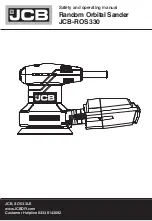
www.silverlinetools.com
5
261345
180W Detail Sander 90mm
Personal Safety
a)
Stay alert, watch what you are doing and use common sense
when operating a power tool. Do not use a power tool while you
are tired or under the influence of drugs, alcohol or medication.
A moment of inattention while operating power tools may result in
serious personal injury
b)
Use personal protective equipment. Always wear eye protection.
Protective equipment such as dust mask, non-skid safety shoes, hard
hat, or hearing protection used for appropriate conditions will reduce
personal injuries
c)
Prevent unintentional starting. Ensure the switch is in the
off-position before connecting to power source and/or battery
pack, picking up or carrying the tool.
Carrying power tools with your
finger on the switch or energising power tools that have the switch on
invites accidents
d)
Remove any adjusting key or wrench before turning the power
tool on.
A wrench or a key left attached to a rotating part of the power
tool may result in personal injury
e)
Do not overreach. Keep proper footing and balance at all times.
This enables better control of the power tool in unexpected situations
f)
Dress properly. Do not wear loose clothing or jewellery.
Keep your
hair, clothing and gloves away from moving parts. Loose clothes,
jewellery or long hair can be caught in moving parts
g)
If devices are provided for the connection of dust extraction and
collection facilities, ensure these are connected and properly
used.
Use of dust collection can reduce dust-related hazards
Power Tool Use & Care
a)
Do not force the power tool. Use the correct power tool for your
application.
The correct power tool will do the job better and safer at
the rate for which it was designed
b)
Do not use the power tool if the switch does not turn it on and off.
Any power tool that cannot be controlled with the switch is dangerous
and must be repaired
c)
Disconnect the plug from the power source and/or the battery
pack from the power tool before making any adjustments,
changing accessories, or storing power tools.
Such preventive
safety measures reduce the risk of starting the power tool accidentally
d)
Store idle power tools out of the reach of children and do
not allow persons unfamiliar with the power tool or these
instructions to operate the power tool.
Power tools are dangerous
in the hands of untrained users
e)
Maintain power tools. Check for misalignment or binding of
moving parts, breakage of parts and any other condition that may
affect the power tool’s operation. If damaged, have the power
tool repaired before use.
Many accidents are caused by poorly
maintained power tools
f)
Keep cutting tools sharp and clean.
Properly maintained cutting
tools with sharp cutting edges are less likely to bind and are easier
to control
g)
Use the power tool, accessories and tool bits etc. in accordance
with these instructions, taking into account the working
conditions and the work to be performed.
Use of the power tool for
operations different from those intended could result in a hazardous
situation
Service
a)
Have your power tool serviced by a qualified repair person using
only identical replacement parts.
This will ensure that the safety of
the power tool is maintained
WARNING:
Before connecting a tool to a power source (mains switch power
point receptacle, outlet, etc.) be sure that the voltage supply is the same as
that specified on the nameplate of the tool. A power source with a voltage
greater than that specified for the tool can result in serious injury to the
user, and damage to the tool. If in doubt, do not plug in the tool. Using a
power source with a voltage less than the nameplate rating is harmful to
the motor.
Sanding Tool Safety
• Before connecting the tool to a power source, ensure that the voltage
supply matches that specified on the rating plate of the tool
• Always wear appropriate protective equipment, including a dust mask
with a minimum FFP2 rating, eye protection and ear defenders.
• Ensure all people in the vicinity of the work area are also equipped with
suitable personal protective equipment
• Take special care when sanding some woods (such as beech, oak,
mahogany and teak), as the dust produced is toxic and can cause
extreme reactions
• Do not sand magnesium or alloys containing a high percentage of
magnesium
• Be aware of paint finishes or treatments that may have been applied to
the material that is being sanded. Many treatments can create dust that
is toxic, or otherwise harmful. If working on a building constructed prior
to 1960, there is an increased chance of encountering lead-based paints
• The dust produced when sanding lead-based paints is particularly
hazardous to children, pregnant women, and people with high blood
pressure. Do not allow these people near to the work area, even if
wearing appropriate personal protective equipment
• Whenever possible, use a vacuum dust extraction system to control dust
and waste
• Be especially careful when using a machine for both wood and metal
sanding. Sparks from metal can easily ignite wood dust. Always clean
your machine thoroughly to reduce the risk of fire
• Work surfaces and sandpaper can become very hot during use, if there
is evidence of burning (smoke or ash), from the work surface, stop and
allow the material to cool. Do not touch work surface or sandpaper until
they have had time to cool
• Do not touch the moving sandpaper
• Always switch off before you put the sander down
• Always unplug the sander from the mains power supply before changing
or replacing sandpaper
• Even when this tool is used as prescribed it is not possible to eliminate
all residual risk factors. If you are in any doubt as to safe use of this tool,
do not use it







































